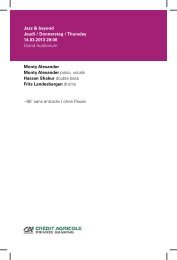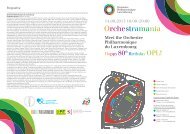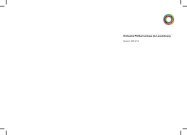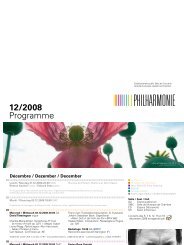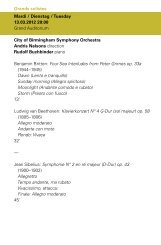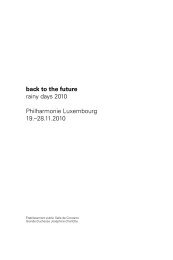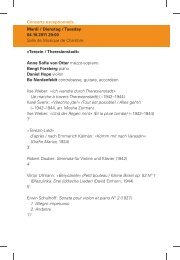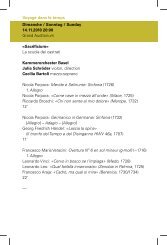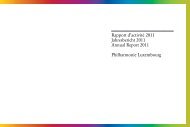Abendprogramm (PDF) - Philharmonie Luxembourg
Abendprogramm (PDF) - Philharmonie Luxembourg
Abendprogramm (PDF) - Philharmonie Luxembourg
Create successful ePaper yourself
Turn your PDF publications into a flip-book with our unique Google optimized e-Paper software.
II.<br />
Not the least obvious of associations suggested by the almost organic relationship<br />
existing between performers and electronics (one of the central points of reference<br />
in Time and Motion Study II) is that of various varieties of execution… The<br />
role of the electronic layout is not restricted here to such tasks as completion,<br />
commentary or support, but, on the contrary, it assumes the position of a weird<br />
«double» (Doppelgänger). Although the electronic equipment offers the texture<br />
the opportunity for self-reflection via repetition, it is only very seldom that the<br />
elements designated for repetition seem willing to subordinate themselves to the<br />
continually unfolding live material.<br />
Because of this, the repetition process frequently brings with it a darkening, a<br />
disturbing, which forms the opposite pole to the highly systematised methods<br />
by means of which the material to be repeated was selected. Repetition as<br />
precondition for a context (continuity): repetition as something superfluous<br />
(leading to fragmentation). Seen from another point of view, one might interpret<br />
this encounter between the self-expression of the individual and the distorting<br />
mirror of collectivity (continually frustrating the desire of the performer to speak<br />
freely) as throwing a little light on the relationship (in the meantime becoming<br />
symbiotic) between the individual and the public spheres of experience.<br />
III.<br />
The work may be conceived of as the interaction, interpenetration and mutual<br />
assimilation of two distinct types of material. The main material consists<br />
of seven times seven rhythmic formulas which ordain the course of events<br />
through a process of continual variation, and in combination with a rigorously<br />
predetermined pattern of phrase-lengths. It is in passages organised according to<br />
these principles that the measurable aspect of time assumes particular importance.<br />
The secondary material consists of a series of individual commentaries on six<br />
distinct basic articulation types – organisms characterised by a much lesser degree<br />
of precompositional definition (i.e. a higher degree of initial abstraction) than is<br />
the case for the other material. There are six examples of between three and six<br />
types in a particular sequence, the unit of form. Each sequence is in turn more<br />
clearly characterised by the predominance within it of one or more main types.<br />
Pitch organization in these sections of the work is less perceptibly fixed in advance<br />
than is the case elsewhere: throughout the composition, pitch organization is<br />
sharply divided into a strict and rigid selection procedure for the main sections<br />
and a method allowing greater and lesser amounts of choice in context (although<br />
the relative degree of choice admitted is also fixed in advance) for the sequences.<br />
The opening of the piece consists of a lengthy passage in which interlocking<br />
fragments of the two basic material categories are «analysed apart» by means<br />
of two tape delay systems with the aid of which the sequences are recorded on<br />
tape during the course of the performance by the assistants and, after a delay<br />
of several seconds, are played back (with a variable degree of distortion arising<br />
from manipulation of the recording volume-control) over whatever the cellist is<br />
playing at the moment. Again and again these fragments serve to hinder the free<br />
unfolding of the live material by reason of their «non-functional» nature. Even<br />
though the main material – at first restricted to scraping and other «impure»<br />
sounds – is not treated in this fashion, it is nevertheless recorded on a further<br />
tape (without the sequences) so that it might be played back at the end of the<br />
composition as part of a pyramidal piling up of sound-strata. After the negotiation<br />
of several intervening episodes, the middle of the work is signaled by another<br />
sort of auto-analysis. At that point rapidly alternating groups of long, held<br />
notes and short, explosive figurations are divided up and assigned, according<br />
to playing technique («arco» or «pizzicato»), to either the lefthand or righthand<br />
loudspeakers, where they are subsequently combined in the stepwise construction<br />
and demolition of superimposed blocks of chordal structures. It is here that the<br />
«optimistic/constructive» potential of the electronic medium is deliberately and<br />
clearly exhibited, even though in practice the clarity is increasingly compromised<br />
by the inevitable errors and differing speeds of reaction on the part of the cellist<br />
99





